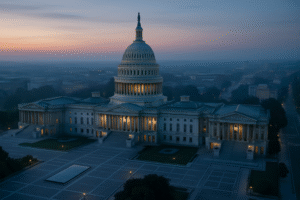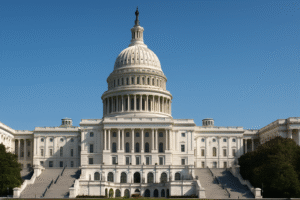Duration & Credit Pulse
Executive Summary
Bottom Line: The government shutdown October 2025 entered its fourth week, creating a significant data void that drove defensive Treasury positioning as the 10-year yield broke below 4% mid-week for the first time since April. While credit spreads remained at historic tights—IG OAS at just 71 basis points—the convergence of regional bank stress, absent economic data, and US-China trade tensions reinforced Treasuries' safe-haven appeal even with a 99.6% probability of a Fed rate cut on October 29.
Duration Dashboard
| Maturity | October 19, 2025 | October 26, 2025 | Weekly Δ | 5-Year Percentile |
|---|---|---|---|---|
| 2‑Year | 3.46% | 3.48% | +2 bp | 38th %ile (middle range) |
| 5‑Year | 3.59% | 3.61% | +1 bp | 43rd %ile (middle range) |
| 10‑Year | 4.01% | 4.00% | -1 bp | 59th %ile (middle range) |
| 30‑Year | 4.61% | 4.59% | -1 bp | 79th %ile (elevated) |
Flight to Quality Flattens Curve
Curve Analysis: Treasury markets exhibited modest bear flattening with the 2s30s spread compressing to 111 basis points from 115bp the prior week. The muted weekly changes—just 1-2 basis points across the curve—belied significant intraday volatility as the 10-year touched 3.967% mid-week before settling at 4.00%. The relative stability in front-end yields despite approaching Fed easing reflects market confidence in the October 29 rate cut, while long-end resilience at elevated percentiles (79th for 30-year) suggests growing term premium demands amid fiscal uncertainties from the 26-day government shutdown.
The government shutdown October 2025 created a substantial information gap that strengthened Treasury demand, as the absence of official employment and inflation data led institutional investors into defensive positioning. The 10-year yield's break below 4% on October 16—touching 3.967% for the first time since April—represented both a technical milestone and psychological inflection point, occurring even as the Fed prepared to cut rates for the third consecutive meeting. The catalyst came from regional banking stress when Zions Bancorporation disclosed $50 million in C&I loan losses while Western Alliance reported collateral concerns, triggering the sharpest regional bank index decline since April's tariff volatility. Strong auction demand validated institutional conviction, with the October 22 sale of $13 billion 20-year bonds clearing more than 1 basis point through the when-issued level despite multi-month yield lows, while the October 23 5-year TIPS auction cleared at 1.182% real yield with a robust 2.51 bid-to-cover ratio.
Credit Pulse
| Metric | October 19, 2025 | October 26, 2025 | Weekly Δ | 5-Year Percentile |
|---|---|---|---|---|
| IG OAS | 73 bp | 71 bp | -2 bp | 9th %ile (extremely low) |
| HY OAS | 278 bp | 269 bp | -9 bp | 17th %ile (low) |
| VIX Index | 20.78 | 16.37 | -4.41 | 32nd %ile (middle range) |
Credit markets displayed notable complacency despite mounting uncertainties, with investment-grade spreads tightening to just 71 basis points—the 9th percentile of their 5-year range and approaching the decade lows of 74bp reached October 7. High-yield compression continued, with spreads narrowing 9 basis points to 269bp (17th percentile), even as regional banking stress emerged mid-week when Zions Bancorporation disclosed $50 million in C&I loan losses. The disconnect between compressed spreads and elevated macro risks suggests stretched positioning that October's record $207 billion investment-grade issuance only amplified.
Balance Sheet & Liquidity Monitor
| Metric | Current Level | Change from Peak | Signal | Historical Context |
|---|---|---|---|---|
| Fed Balance Sheet | $6.6 Trillion | -$2.2T (-25%) | QT Ongoing | Lowest since March 2020 |
| Repo Facility Usage | $1.5 Billion | +$1.5B (Sep) | Stress Emerging | First usage since 2020 |
| MOVE Index | 68.94 | -6.90% weekly | Vol Declining | Below 80 stress threshold |
| Treasury Futures Long | $700+ Billion | Record High | Crowded Long | Highest positioning ever |
The Federal Reserve's quantitative tightening program approached a critical inflection point during the week, with Chair Powell's October 14 acknowledgment that the Fed "may approach that point in coming months" signaling potential policy shift. The $2.2 trillion balance sheet reduction since June 2022 has reduced system liquidity to levels where stress indicators—particularly the Standing Repo Facility's $1.5 billion September usage—echo patterns last seen before the September 2019 repo market disruption. Multiple primary dealers including JPMorgan and Bank of America expect QT cessation announcement at the October 29 meeting, recognizing that further reduction risks market functioning even as inflation remains above target.
US Macroeconomic Assessment – Shutdown Constrains Data Flow
The week of October 19-26 witnessed the federal government shutdown's transformation from political disagreement to genuine economic constraint, as the 26-day closure approached the second-longest in US history. The impasse over Affordable Care Act premium subsidies—Republicans demanding cuts to the $400 billion decade-long program—left 900,000 federal workers furloughed and 2 million working without pay, creating ripple effects through government contractors and dependent businesses. More critically for markets, the data void eliminated virtually all visibility into economic conditions just as the Fed prepared for its October 29 policy decision.
CPI provides only official economic data point: The Bureau of Labor Statistics' October 24 release of September CPI—legally mandated for Social Security COLA calculations—provided the week's only official economic metric. Headline inflation printed at 3.0% year-over-year (versus 3.1% consensus), with core CPI also at 3.0% (versus 3.1% expected). Month-over-month readings showed encouraging deceleration: 0.3% headline (versus 0.4% expected) and 0.2% core (versus 0.3% expected). Gasoline rose 4.1% monthly while shelter gained just 0.2%, its smallest advance in years. The clean inflation print solidified expectations for the Fed's third consecutive rate cut, with fed funds futures pricing a 99.6% probability of a 25 basis point reduction to 3.75%-4.00%.
Private data provides limited visibility: S&P Global's flash PMIs on October 24 painted a mixed picture: manufacturing PMI edged up to 52.2 from 52.0, while services PMI surged to 55.2 from 54.2, marking a three-month high. Yet consumer sentiment told a darker story, with the University of Michigan's final October reading declining to 53.6, down 1.4 points from preliminary levels and the lowest since May. One-year inflation expectations jumped to 4.6% (up 1.6 percentage points), with 44% of consumers spontaneously mentioning high prices—the highest share in a year. The divergence between solid business activity and deteriorating consumer confidence highlighted the shutdown's psychological impact beyond mere data availability.
Labor market data unavailable due to shutdown: The complete absence of official jobless claims data led economists to compile state-level reports, estimating approximately 227,000 initial claims for the week ending October 18. The September employment report, originally scheduled for October 4, remained postponed until November 7 at the earliest, leaving the Fed without its most critical labor market gauge. Private sector data suggested continued tightness—ADP reported modest gains—but federal workforce disruptions and multiplier effects through contractors created unmeasurable slack. The information vacuum complicated the Fed's dual mandate calculus at precisely the moment clarity was essential.
Federal Reserve Policy Outlook – October 29 Meeting Approaches
The Federal Reserve's October 29 meeting represents a significant challenge since the inflation fight began, with markets pricing near-certainty of a 25 basis point cut to 3.75%-4.00% despite the notable absence of current economic data. Chair Powell's October 14 speech signaled growing urgency to halt quantitative tightening, noting the Fed "may approach that point in coming months" as liquidity conditions showed "signs of gradually tightening." With the balance sheet down $2.2 trillion to $6.6 trillion and repo facility usage reaching $1.5 billion in September, multiple Wall Street banks expect QT cessation announcement at the October meeting.
Internal divisions crystallized when Governor Miran advocated for a 50 basis point cut on October 16, reprising his September dissent, while Governor Waller explicitly backed 25 basis points based on "conflicting signals between solid GDP growth and softening employment." The September FOMC minutes revealed "almost all participants supported" the measured pace, though "a majority emphasized upside risks to inflation." Without fresh data to adjudicate between doves focused on labor market deterioration and hawks worried about premature easing, the Committee must rely on dated information—a challenging situation when fiscal disruption and trade uncertainty cloud the outlook. Powell's press conference will require careful navigation to maintain credibility while acknowledging the informational constraints affecting policy precision.
Week Ahead: Key Market Events
- FOMC Meeting (October 28-29): 25bp cut appears locked despite data vacuum. Markets focus on dot plot revisions, QT halt timing, and Powell's navigation of shutdown impacts on policy framework.
- Trump-Xi Summit (October 30): APEC meeting in South Korea where preliminary trade agreement reached October 26 gets finalized. Tariff reduction specifics and enforcement mechanisms critical for risk appetite.
- Government Shutdown Resolution: Senate attempting override of spending impasse before month-end. Restoration of data flow would eliminate primary uncertainty driver but reveal accumulated economic damage.
- Bank of Japan Decision (October 29-30): Expected 25bp hike to 0.75% creates cross-current for US Treasuries. Yen strength could reduce Japanese demand for US duration.
- Month-End Flows: Massive October Treasury rally (+2.5% total return pace) may trigger rebalancing sales. Pension funds likely sellers into strength given equity outperformance year-to-date.
Global Context and Fed Rate Cut October 2025 Implications
The Federal Reserve's isolation as the sole major central bank aggressively easing creates significant policy divergence with important implications for Treasury demand and dollar dynamics. While the Fed approaches its third consecutive cut, the ECB holds firm at 2.00% with President Lagarde declaring the "disinflation process is now over," the Bank of Japan prepares to hike to 0.75%, and even the Bank of England maintains its hawkish bias despite UK economic weakness. This divergence, amplified by the government shutdown's fiscal uncertainty, tests whether US exceptionalism can withstand simultaneous monetary accommodation and political dysfunction.
Energy weakness creates disinflationary pressure: The week's overlooked story centered on crude oil's continued decline, with WTI settling at $61.60 per barrel (down 8.58% year-over-year) and Brent at $65.83 (down 7.28% YoY), extending the surplus conditions persistent since early 2025. Ed Yardeni's projection that 10-year yields could reach 3.75% if oil's slide continues gained credibility as the September data showed a massive 102 million barrel increase in oil on water—the largest since COVID. The EIA's forecast for Brent at just $52/barrel in 2026 suggests sustained disinflationary pressure that complicates the Fed's reaction function. Yet 5-year breakeven inflation expectations at 2.74% remain stubbornly above the Fed's 2% target, creating a paradox where falling energy prices fail to anchor inflation expectations—potentially reflecting tariff concerns or fiscal dominance fears that transcend commodity price signals.
Trade breakthrough offers tactical relief, not strategic resolution: The October 26 preliminary consensus between US and Chinese negotiators in Kuala Lumpur, covering rare earths access, fentanyl precursors, and soybean purchases, sparked risk-on sentiment into week's end. Treasury Secretary Bessent's confirmation that threatened 100% tariffs were "effectively off the table" ahead of the Trump-Xi summit provided tactical relief to duration shorts. Yet with enforcement mechanisms undefined and structural tensions unresolved, markets recognize this represents crisis postponement rather than resolution. The combination of Fed easing, fiscal paralysis, and trade uncertainty creates conditions where traditional correlations break down—evident in credit spreads at historic tights while safe-haven Treasuries rally. October's 10-year yield break below 4% may prove temporary as November brings converging catalysts: Fed decisions, trade negotiations, and potential ratings agency reviews on US fiscal sustainability should the shutdown persist.
Key Articles of the Week
-
Fed's Portfolio Unwind Gains Urgency as Markets Flash WarningsBloombergOctober 24, 2025Read Article
-
CPI Inflation September 2025: Inflation Rate Hit 3%, Lower Than ExpectedCNBCOctober 24, 2025Read Article
-
Effort to Pay Federal Workers During Shutdown Fails in SenateNPROctober 23, 2025Read Article
-
Treasuries Rally Drives Home Haven Role as Credit Worries SwirlBloombergOctober 19, 2025Read Article
-
Fed Making Key Economic Decisions Without Key Economic DataThe American ProspectOctober 21, 2025Read Article
-
Credit Spreads Hover Near Historic Lows: Market Health or Complacency?FinancialContentOctober 27, 2025Read Article
-
Treasury 10-Year Yields May Hit 3.75% on Oil Slide, Yardeni SaysBloombergOctober 21, 2025Read Article
-
US, China Tee Up Sweeping Trade Deal for Trump, Xi to FinishBloombergOctober 26, 2025Read Article
Frequently Asked Questions
What impact did the government shutdown October 2025 have on Treasury yields?
The 26-day government shutdown created a significant data void that drove Treasury yields lower, with the 10-year breaking below 4% mid-week for the first time since April. The absence of official economic data led to defensive positioning among institutional investors, reinforcing Treasuries' safe-haven status despite approaching Fed rate cuts.
Why are credit spreads at historic lows despite the government shutdown?
Investment-grade spreads at 71 basis points (9th percentile) and high-yield at 269bp (17th percentile) reflect notable complacency as investors chase yield ahead of expected Fed easing. This compression overlooks growing risks from the shutdown, regional bank stress, and trade uncertainties—a disconnect similar to conditions seen before the February 2020 spread widening.
How will the Fed navigate its October 29 meeting without economic data?
The Federal Reserve faces its October 29 decision with limited data, with only September's CPI available due to the shutdown. Markets price 99.6% probability of a 25bp cut to 3.75%-4.00%, but the Committee must rely on stale data and private sector indicators while potentially announcing the end of quantitative tightening to address emerging liquidity concerns.
What are the key market catalysts for the week following October 26, 2025?
Three important events occur next week: the October 29 FOMC meeting where rate cuts and QT cessation are expected, the October 30 Trump-Xi summit to finalize preliminary trade agreements, and potential government shutdown resolution before month-end. These events will determine whether October's Treasury rally extends or reverses as November begins.







